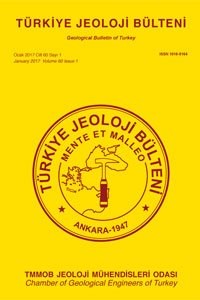Pliocene-Lower Pleistocene Ostracoda Fauna from İnsuyu Limestone (Karapınar-Konya/Central Turkey) and its Paleoenvironmental Implications / Pliyosen-Pleyistosen Yaşlı İnsuyu Kireçtaşı'nın Ostrakod Faunası (Karapınar-Konya/İç Anadolu, Türkiye) ve Eski Ortamsal Yorumu
Öz
The study area is located in the southern part of the Central Anatolia Neogene Basin (north of Karapınar Town and Acı Göl, Konya). The İnsuyu Limestone Unit, which has a total thickness of 100-400 m, is composed of claystone, sandstone, conglomerate and chert. There are also andezite and pyroclastic interclations within İnsuyu limestone. The claystone layers of this unit are white to pink in color and contain abundant Ostracoda and a few fresh water Gastropoda. In this study, 160 samples from 8 stratigraphic sections were collected but only samples having limestone lithology contained ostracods. Atotal of 16 ostracods taxa (11 previously known and five belonging to open nomenclature) are systematically described as Cyprideis pannonica, C. torosa, Ilyocypris gibba, I. bradyi, Candona neglecta, C. candida, C. altoides, C. decimai, Pseudocandona compressa, Heterocypris salina, Zonocypris membranea, Ilyocypris Candona , Candona Pseudocandona Cypridopsis sp. sp.1 sp.2, sp. and sp. Based on this Ostracoda fauna, the age of this unit is assigned as Pliocene-Early Pleistocene. This fauna indicates a few brackish but dominantly fresh water conditions in a lacustrine environment.
Anahtar Kelimeler
Fresh water Ostracoda İnsuyu Limestone Unit Pliocene-Early Pleistocene systematics
Kaynakça
- Agalarova, D.A., 1956. Microfauna from Productive Beds in Azerbaijan and Red Deposits in Turkmenistan,
Ayrıntılar
| Bölüm | Makaleler - Articles |
|---|---|
| Yazarlar | |
| Yayımlanma Tarihi | 1 Nisan 2008 |
| Gönderilme Tarihi | 28 Mart 2017 |
| Yayımlandığı Sayı | Yıl 2008 Cilt: 51 Sayı: 1 |
Kaynak Göster
Yazım Kuralları / Instructions for Authors / http://www.jmo.org.tr/yayinlar/tjb_yazim_kurallari.php
Etik Bildirimi ve Telif Hakkı Devir Formu / Ethical Statement and Copyrighy Form / https://www.jmo.org.tr/yayinlar/tjb_telif_etik_formlar.php


